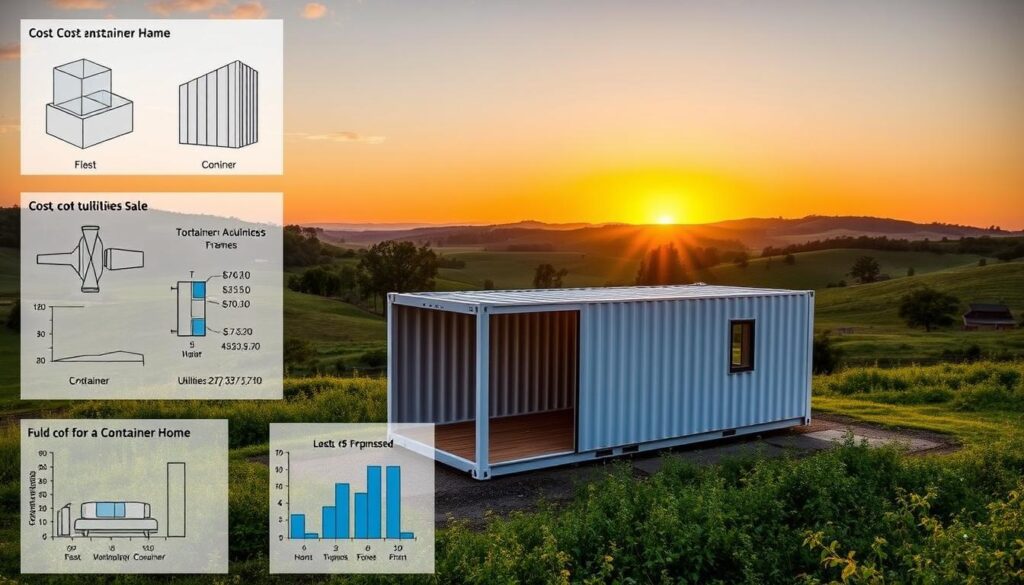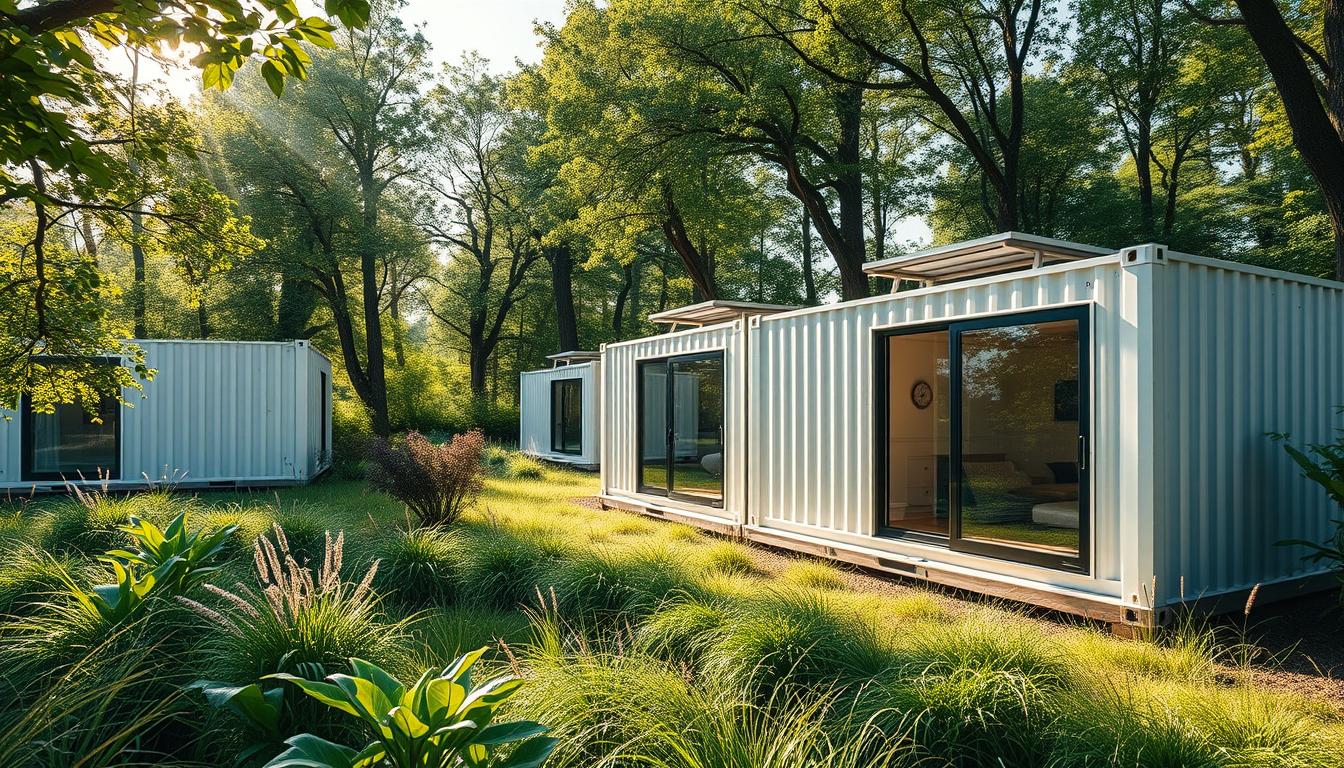Did you know over 14 million shipping containers are in use worldwide? Many are being turned into unique homes. This is a big change in sustainable living.
These eco-friendly housing options are not only cheap but also stylish. They show off modern architecture. By using old shipping containers, we cut down on waste and make cool homes.
Let’s dive into the world of interior shipping container homes. We’ll see how they’re making a difference in housing.
Key Takeaways
- Eco-friendly housing solutions through repurposed shipping containers.
- Affordability and sustainability in modern architecture.
- Unique living spaces that are gaining global popularity.
- Reduction in waste through the reuse of shipping containers.
- Innovative designs that embody modern living.
What Are Interior Shipping Container Homes?
Turning shipping containers into homes is a creative way to build houses. It combines sustainability with modern design. These homes are made from old shipping containers, offering an eco-friendly choice compared to traditional houses.
These homes are not just good for the planet. They are also very customizable. Homeowners can design and renovate them to fit their needs perfectly. It’s important to know the benefits and common myths about container homes.
Overview of Container Homes
Container homes are built from shipping containers. These containers are strong, secure, and easy to find. Turning them into homes requires careful planning and design.
For those thinking about building a container home, doing thorough research is key. As Discover Containers points out, understanding the challenges and opportunities can greatly impact the outcome.
Benefits of Container Living
Living in a container home has many advantages. These homes are sustainable, affordable, and flexible. They are made from recycled materials, which is good for the environment. They are also cheaper than traditional houses, making them appealing to first-time buyers or those on a tight budget.
Another big plus is how flexible container homes are. They can be easily changed or expanded as needed. This allows homeowners to adjust their living space as their needs change.
| Benefits | Description |
|---|---|
| Sustainability | Made from recycled shipping containers, reducing waste and environmental impact. |
| Affordability | Often more affordable than traditional housing, making them accessible to a wider audience. |
| Flexibility | Easily expandable or modifiable to suit changing needs. |
Common Misconceptions
Despite their growing popularity, container homes still face some myths. One is that they are cramped and uncomfortable. But with the right design and renovation, they can be spacious and cozy, blending modern comforts with industrial charm.
Another myth is that container homes are not durable. But shipping containers are built to last, making them a solid base for homes.
Design Ideas for Shipping Container Interiors
Turning a shipping container into a home needs smart interior design. It’s key to use the space well in these homes.
Open Concept Living
One smart way to make a shipping container home feel bigger is open concept living. Fewer walls and partitions make the space feel larger and airier. This design also improves how different areas of the home connect.
Utilizing Natural Light
Natural light can change a shipping container home’s feel. Windows and skylights placed right can brighten the inside. This makes the home feel more inviting and can cut down on the need for artificial light.
Multi-functional Spaces
In small spaces like container homes, it’s vital to have multi-functional spaces. For instance, a living area can also be a guest bedroom with a murphy bed. A kitchen island can be both for food prep and dining. This way, you use every bit of space.
Creative Storage Solutions
Storage is crucial in container home design. Creative storage solutions like built-in shelves and hidden spots keep things organized. Using space under floors, above ceilings, or in walls helps keep the home neat and useful.
By using these design tips, homeowners can make their shipping container home both beautiful and practical.
Sustainability of Container Homes
Using shipping containers for homes cuts down on waste and supports sustainable living. It gives old materials a new life and lowers the need for new ones.
Eco-friendly Building Materials
Container homes use eco-friendly building materials. The steel they’re made of is durable and recyclable. This reduces waste and the demand for new materials.
Homeowners can also choose sustainable materials for insulation and flooring. For example, recycled insulation or reclaimed wood for floors makes the home greener. Plus, picking materials with low VOCs improves air quality inside.
Energy Efficiency Benefits
Container homes are energy efficient. Their small size means less space to heat and cool, saving energy. The right insulation and windows keep temperatures comfortable with little energy use.
Homeowners can make these homes even more efficient. Installing solar panels, using energy-saving appliances, and letting in natural light are good ideas. This reduces the need for artificial lighting.
Reducing Waste in Construction
Building traditional homes often creates a lot of waste. But, using shipping containers cuts down on this waste. The containers are already made, so less new material is needed.
Building in a factory or yard before moving to the site further reduces waste. This method supports eco-friendly housing and makes building more efficient and less messy.
In summary, container homes are a great choice for affordable homes that are also good for the planet. They use recycled materials, are energy efficient, and reduce waste in construction. These homes truly represent sustainable living.
Cost Considerations for Building a Container Home
Building a container home involves looking at the initial cost and long-term savings. It’s important to understand these costs to make a smart choice.
Initial Investment and Setup Costs
The cost of a shipping container can be low. But turning it into a home can cost more. The condition, size, and design complexity affect the cost.
Key costs to consider include:
- Purchase price of the shipping container
- Modification costs (cutting windows, doors, etc.)
- Insulation and climate control systems
- Plumbing and electrical installations
Choosing energy-efficient options for your container home renovation might raise the initial cost. But it can save money over time.

Long-term Savings and Financial Benefits
Container homes offer long-term savings. Using recycled materials like the container itself cuts down on waste and costs.
They can also be very energy-efficient. This means lower utility bills. Adding solar panels and rainwater systems can make them almost self-sufficient.
Comparing Costs with Traditional Homes
Container homes have different costs than traditional homes. The initial cost of a container might be lower. But the cost of making it a home can add up.
Still, container homes are often cheaper in the long run. They save on energy and maintenance. This makes them a great choice for affordable homes that are stylish and comfortable.
In summary, building a container home has its costs. But with careful planning, it can be a smart and affordable choice.
Finding the Right Location for Your Container Home
Finding the perfect spot for your container home is key. It affects how your home looks, works, and is good for the planet.
Urban vs. Rural Settings
Choosing between an urban or rural spot is a big decision. Urban areas are close to shops, buses, and jobs. But, they cost more and have strict zoning regulations.
Rural settings are calm and have lots of room, often for less money. But, they might not have all the amenities and you’ll have to travel further.
- Urban advantages: close to shops, buses, jobs
- Urban disadvantages: more expensive, strict rules
- Rural advantages: peaceful, lots of room, cheaper
- Rural disadvantages: fewer amenities, longer travel
Zoning and Building Regulations
It’s important to know the local zoning and building regulations before you decide. These rules affect your home’s size, design, and where it goes.
- Look up local zoning laws
- Get the right building permits
- Follow environmental rules
Accessibility and Utilities
Make sure your container home is accessible and has the right utilities. You need clean water, electricity, and a way to get rid of waste. Also, think about the road to your home and internet access.
| Utility | Considerations |
|---|---|
| Water | Connection to city water or a well |
| Electricity | Connection to the grid or solar power |
| Sewage | Connection to city sewage or a septic tank |
By looking at these points, we can find a place that meets our needs and improves our life.
Customizing Your Container Home
With a shipping container as your base, the design possibilities are vast. It’s a blank slate for your creativity. Making your container home feel like home involves personalizing various elements.

Interior Design Styles
Choosing the right design style is key for container homes. Styles like modern, industrial, and minimalist offer unique looks. For example, an industrial style might keep the metal walls, while modern styles go for sleek finishes.
When picking a style, consider:
- The container’s original structure and how it can be highlighted or modified
- The desired ambiance and functionality of the space
- The incorporation of sustainable and eco-friendly elements
Choosing Colors and Finishes
Colors and finishes are crucial for personalizing your home. The right colors can brighten up the space and make it feel larger. Lighter colors can open up a room, while darker tones add warmth.
When choosing colors and finishes, think about:
- The psychological impact of different colors
- The durability and maintenance needs of various finishes
- How different elements will work together for a cohesive look
Adding Unique Features
Unique features can make your container home truly special. This could be custom furniture or smart home tech. Adding sustainable energy solutions can also boost value and function.
For more ideas on enhancing your container home, check out US LinkedIn Services. They offer resources and expertise for customizing your space.
By focusing on these areas, you can create a home that’s both functional and a true reflection of your style and values.
Essential Utilities and Amenities
Turning a shipping container into a home needs careful planning. We must think about utilities and amenities. This ensures our home is both cozy and eco-friendly.
Water and Plumbing Systems
Having a good water and plumbing system is key. We should decide on our water source and design our plumbing to save water. Efficient plumbing cuts down on water use and bills.
It’s also smart to use sustainable living practices. This includes low-flow fixtures and greywater systems. These steps help reduce our environmental impact.
Electrical Considerations
Electrical systems are also crucial. We need to wire our home safely and efficiently. Choosing the right materials and following local codes is important. Energy efficiency is key, with options like LED lights and energy-saving appliances.
Looking into renewable energy sources like solar or wind power is a good idea. It cuts down on grid use and lowers bills. This is good for the planet and our wallet.
Heating and Cooling Options
Keeping our home comfortable is vital. We have many heating and cooling options. From traditional HVAC to radiant floor heating or evaporative cooling, the choice depends on our needs and budget.
When picking a system, focus on energy efficiency. For example, a heat pump might cost more upfront but saves on bills over time.
By planning and installing these utilities and amenities well, we can make a shipping container home. It will be unique, stylish, comfortable, sustainable, and fully functional.
Interior Container Home Maintenance
To keep your container home in top shape, a routine maintenance schedule is key. This proactive approach helps spot and fix issues early on.
Routine Maintenance Tips
Regular upkeep is crucial for your container home’s longevity. Regularly check your home’s exterior and interior for signs of wear like rust, dents, or water leaks. Also, inspect the roof, walls, and foundation for damage or weak spots.
- Check for rust and corrosion on metal surfaces.
- Inspect and maintain the roof to prevent leaks.
- Ensure all doors and windows are sealed properly.
Dealing with Moisture and Insulation
Moisture control is vital in container homes because of their metal build. Proper insulation helps manage temperature and prevents condensation. Make sure your home is well-insulated and use moisture-resistant materials for finishes.
- Use appropriate insulation materials to prevent condensation.
- Ensure good ventilation to reduce moisture buildup.
- Regularly inspect for signs of moisture damage.
Long-term Care for Container Homes
Long-term care goes beyond routine maintenance. It requires a detailed plan to keep your home in good condition. Regularly review and update your maintenance schedule as needed. Consider environmental conditions and your home’s age.
By following these tips, you can keep your container home safe, comfortable, and sustainable for years.
Success Stories: Real-Life Examples
Exploring interior shipping container homes shows us their potential. We see how design, sustainability, and cost come together in real homes. These stories inspire us with their creativity and practicality.
Inspiring Transformations
Many have turned a simple container into a cozy home. For example, a family in California made a modern, eco-friendly home. It had a rooftop garden and solar panels. These stories show us the power of creative living.
Testimonials from Container Homeowners
Those who live in containers love their simplicity and efficiency. They talk about the savings on energy and the freedom to live anywhere. Their stories highlight the benefits of container homes.
Lessons Learned from Container Living
Container living has its perks, but it also comes with challenges. Homeowners share their experiences with zoning and keeping a comfortable climate. Their advice helps those thinking about container living.



